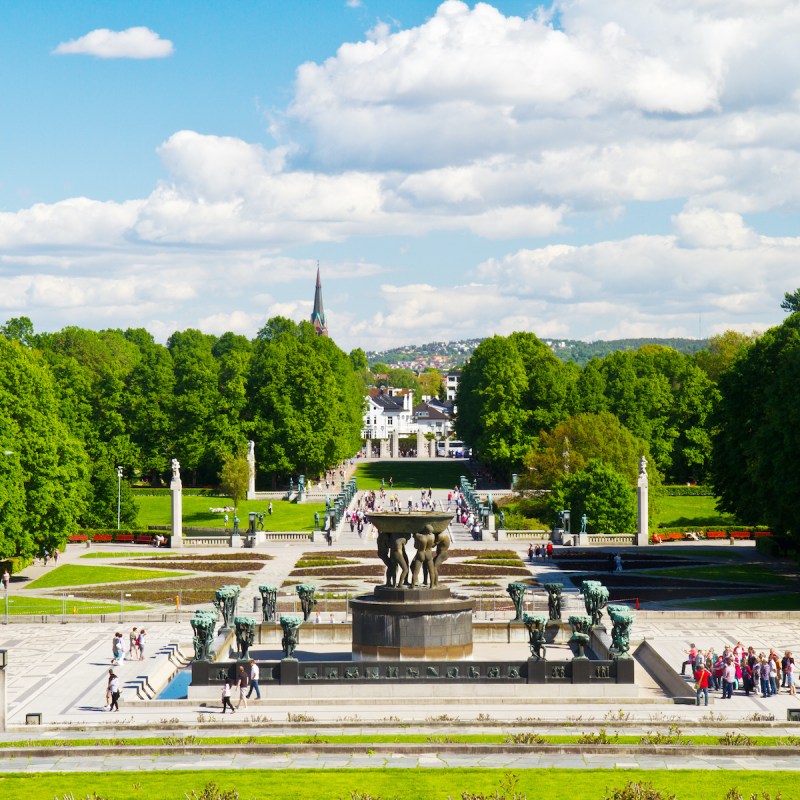
Set on a glittering bay amid impressive hills and fjords, Oslo is one of Scandinavia’s most magnificent cities. Founded by a Norseman, King Harald III, the city has a rich Viking history with close ties to the sea.
Videos by TravelAwaits
Our Viking Venus Ocean Ship docked at the Akershus Fortress, a medieval and Renaissance citadel built in the 1290s by Norse King Hakon V, central to Norway’s identity. Oslo was one of the stops during our 2-week Norwegian Homelands cruise from Stockholm to Bergen.

1. The Parks And Green Spaces In Oslo
A nature walk is always top of mind in Oslo, situated between the waters of Oslofjord and the sloping forests that spread into the hinterlands or areas inland from the coast. Ample parks and open spaces invite residents and guests to commune with nature. Norway’s most famous is Frogner Park, home to Gustav Vigeland’s renowned sculptures.
A short ferry takes you to Bygdoy, the green “Museum Peninsula” protruding into the fjord. St. Hanshaugen Park, with rolling hills and romantic pathways, features broad city views. The grassy stretch of Toyen Park and an inviting botanical garden extend behind the Munch Museum.

2. Edvard Munch Museum
Dedicated to the life and art of the Norwegian artist Edvard Munch, the original museum opened in 1963, commemorating his 100th birthday. On October 22, 2021, the new museum opened with an extensive collection of over 1,200 paintings,18,000 prints, 2,240 books, 500 plates, six sculptures, and other prominent items by Munch.
I was fascinated to find more than four versions of the famous Scream, an 1893 oil, tempera, and pastel; an 1895 pastel on board; an 1895 lithograph; and a 1910 tempera on panel. The artist described his scream of nature as the sun went down, the sky turned a bloody red, and he trembled in anxiety.
3. The National Gallery Of Oslo
In 1910, the iconic Scream, painted in 1893, was donated to the National Gallery in Oslo. The Edvard Munch Room features 18 of his most famous paintings, including Madonna, The Sick Child, The Dance of Life, and The Girls on the Pier.
The new National Museum opened on June 11, 2022, and houses Norway’s most extensive collections of older and modern art, architecture, design, arts and crafts, and contemporary art, all presented under one roof and in new settings. Some exhibitions include United States artist Mark Rothko, Mexican artist Freda Kahlo, and Else Hagen, the first female artist in Norway to create monumental public artworks.

4. Frogner Park And Gustav Vigeland’s 200 Sculptures
The largest sculpture park by a single artist in the world, Frogner Park houses over 200 bronze, granite, and cast-iron sculptures by acclaimed Norwegian sculptor Gustav Vigeland. Vigeland Square is within Frogner Park, the most significant park in Oslo. Frogner also hosts an open-air pool, a café and restaurant, the grandest playground in Norway, and the country’s most prominent collection of roses, with 14,000 plants and 150 different species. The park is also home to Frogner Manor and the Museum of Oslo, telling the city’s history through paintings, models, and photographs.
The Monolith is the center of the park’s sculptures, a tribute to humankind’s complexity. Carved from a gigantic stone block and the highest point in Vigeland Park, the Monolith represents 121 humans stacked, clinging to each other, with children at the top. Each figure depicts a different stage of life.
The famous Bridge hosts 58 bronze sculptures of men, women, and children, while the Fountain features 20 statues from all stages of life, from childhood to old age and death. Other outstanding sculptures include the Dancing Young Woman, Man Fighting Lizard, and The Wheel of Life, a bronze circle of human figures.
The most humorous sculpture I found was The Angry Boy, a little boy throwing a temper tantrum. Vigeland was said to have given the boy some candy and then taken it away. His angry expression made me laugh. You could spend all afternoon in this park.

5. Oslo City Hall, Home To The Nobel Peace Prize Ceremony
On December 10, the anniversary of Alfred Nobel’s death, Oslo City Hall hosts the Nobel Peace Prize ceremony, where the annual laureate presents their lecture and receives the medal and diploma. The awards presentation takes place in the grand Central Hall, surrounded by murals of artist Henrik Sorensens depicting scenes from Norwegian history and legends.

6. The Royal Palace
The opulent Royal Palace is one of the country’s most important buildings, owned by the state and provided for the head of state. The King and Queen live here and conduct the daily work of the monarchy. The King presides over the Council of State, holds official dinners, and grants audiences. Foreign heads of state who visit Oslo stay at the palace, and most of the members of the Royal Court have offices here. The castle was officially established on July 26, 1849, by King Oscar I.
Pro Tip: The Royal Palace is open for summer tours from June 25 through August 18, with tickets available on Ticketmaster.
7. Norwegian Parliament
Guided tours of the Norwegian Parliament, or Storting, are available weekdays from July 11 to August 12. Since 1866, The Grand Storting has been the main arena for the Kingdom of Norway’s political debate and decision-making. The building features a round dome with two wings protruding like arms embracing the citizens.

8. The National Theatre
One of Norway’s most prominent and grandest venues for dramatic arts performances, The National Theatre celebrated its first performance on September 1, 1899. Designed by architect Henrik Bull, the building has served Norway’s stage artists, theater productions, and celebrations for over 100 years. The main building is between the Royal Palace, Oslo, and the Parliament of Norway. Statues of Norwegian writers Bjornstjerne Bjornson and Henrik Bull guard the front entrance. They also have their names engraved on the main wall of the theater, along with Ludvig Holberg, the Danish Norwegian playwright.

9. Holmenkollen Ski Museum And Tower
Holmenkollen District, home to the world-famous ski jump set atop the most prominent hill in the city, dates back to 1892. Made of 1,000 tons of steel and rising over 196 feet, designers brought together the ski jump, the judges’ booths, the Royal family observatory, souvenir shop, café, ski simulator, zip lining, and the museum.
Pro Tip: See a panoramic view of Oslo at the top of the tower.

10. Norwegian Museum Of Cultural History
Inside the open-air Museum of Cultural History, you’ll find 160 historical buildings in city and countryside settings. Fences, pastures, and grazing farm animals frame sod-roofed farmhouses. The cobblestone streets of the museum’s old town feature quaint stores, workshops, and homes. In the indoor exhibition halls, see historic furniture, silverware, handicrafts, and clothing and watch live folk dancing, storytelling, and baking. See the Gol Stave Church built in the 1200s.
Pro Tip: Don’t miss the cafe and gift shop.
11. Norwegian Maritime Museum
Situated on the waterfront of the Bygdoy Peninsula, the Norwegian Maritime Museum combines Norwegian maritime history, underwater technology, and shipbuilding. Two new exhibitions in 2022 feature a reconstruction of a Viking boat — one of the original boats from Gokstad, a huge Viking ship from 900 AD found in a burial mound in 1880. The triangular-shaped Boat Hall has reopened with a collection of traditional open boats, including a shipwreck from the end of the 16th century. You’ll also see The Stokkebaten, Norway’s oldest ship dating from 200 BC, plus Discover the Sea, an exhibition about myths, monsters, and heroes of the sea.

12. The Norwegian National Opera And Ballet
Oslo Opera House, located at the harbor, is a prominent white, angled exterior that rises from the water, inviting visitors to climb to the top of the roof to see panoramic views of Oslo and the fjord. The award-winning horseshoe-shaped main hall, an iceberg-inspired design by Norwegian architecture firm Snohetta, features large-scale windows with glimpses of rehearsals and workshop activities. The venue features three stages — the Main House, Second House, and the Studio — with the roof and foyer also used for concerts.
13. Fram Museum, The Polar Ship Fram
At the Fram Museum, see the strongest wooden ship ever constructed, still holding the records for sailing farthest north and farthest south. Check out the polar simulator where you can experience the cold and dangers of polar expeditions more than 100 years ago. Step aboard the ship to see how the crew and their dogs survived the Arctic and Antarctic.
Pro Tip: Visit the museum shop for exclusive polar merchandise.

14. TusenFryd Amusement Park
Norway’s largest amusement park, TusenFryd, features over 30 rollercoasters, carousels, log rides, attractions, great games, shops, restaurants, friendly trolls, and fun for all ages. Enjoy BadeFryd in the summer, a water park with a swimming pool, a lazy river, and a giant waterslide. Barnas Fryd and Fredskogen boast rides and activities for the grandchildren.
Pro Tip: The Oslo Pass provides free admissions to 30 museums and attractions in Oslo. You can also get unlimited travel on public transportation throughout the city. Conveniently hop on or off any bus, tram, subway, or public ferry as you wish, without worrying about tickets. Plus, you’ll get special offers at restaurants, shops, or entertainment and leisure venues. Or, enjoy rebates on climbing, ski rentals, sightseeing, concert tickets, or the Tusenfryd Amusement Park.
Related Reading:
